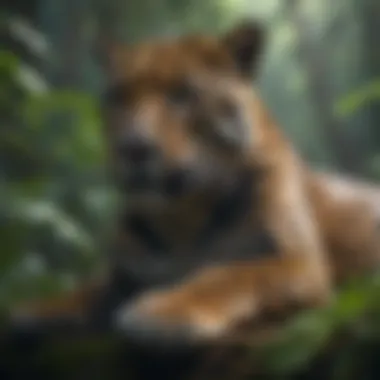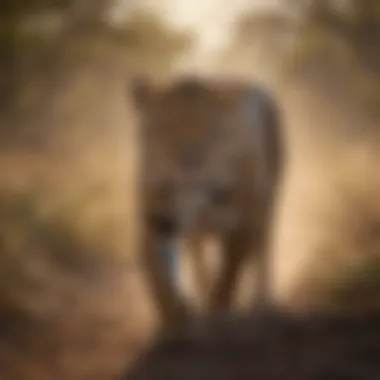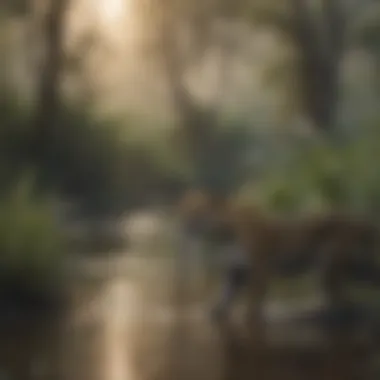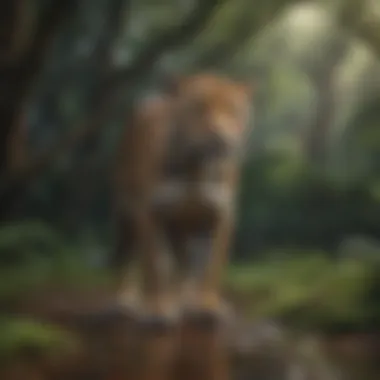The Habitat of the Jaguar: A Comprehensive Overview


Intro
Jaguars are one of the most remarkable big cats in the Americas. Their presence spans a variety of ecosystems, showcasing their adaptability. Understanding the jaguar's habitat is vital for conservation efforts. This overview outlines the key aspects of their environment, behavior, and the challenges they face. It is an attempt to educate about these magnificent cats and the need to protect their habitats.
Animal Overview
Common Name and Scientific Classification
The common name "jaguar" refers to the species Panthera onca. This feline is the largest cat in the Americas and the third-largest in the world. Its classification places it within the family Felidae, which includes all modern cats.
Physical Characteristics
Jaguars possess distinct physical traits. They are known for their muscular build and powerful jaws. Generally, adult jaguars weigh between 100 to 250 pounds. Their fur is typically a tawny yellow or brown, covered in black rosettes which assist with camouflage. This coloration helps them blend into their environment.
Habitat and Distribution
Jaguars have a broad habitat range. They primarily inhabit tropical rainforests, but can also be found in savannas, scrublands, and wetlands. Their geographic distribution extends from the southern United States down to South America, specifically in countries like Brazil, Colombia, and into parts of Central America. These cats prefer areas close to water sources, as they are strong swimmers.
Behavior and Social Structure
Communication Methods
Jaguars communicate through vocalizations, body language, and scent marking. They can produce a variety of sounds, including growls, roars, and meows. They use these sounds during mating rituals or to establish territory.
Social Hierarchies
Unlike some other big cats, jaguars are generally solitary. They establish large territories that they defend against others. Males often roam larger areas than females, who tend to stay closer to their den.
Mating and Reproductive Behavior
Mating usually occurs during the dry season. After a gestation period of about 93 to 105 days, females give birth to one to four cubs. The cubs are born blind and rely heavily on their mother for protection and sustenance until they are old enough to hunt.
Conservation Status
Current Population Trends
The jaguar population has seen significant declines due to habitat loss and poaching. Current estimates suggest that the population is around 170,000 individuals in the wild. However, this number is hard to verify due to their elusive nature.
Threats and Challenges
Several threats are contributing to the decline of jaguar populations. Deforestation for agriculture is a primary concern. Additionally, poaching for the illegal wildlife trade puts pressure on their numbers. Human-wildlife conflict also hinders their survival as they sometimes prey on livestock.
Conservation Efforts and Success Stories
Conservation initiatives are essential for the survival of jaguars. Some organizations focus on habitat preservation and anti-poaching efforts. Protected areas like the Pantanal and the Amazon Rainforest serve as sanctuaries. There are success stories where population numbers have begun to stabilize due to these efforts. Supporting community-based conservation programs can also help engage local populations in protecting jaguars.
"Protecting jaguar habitats is not just about saving a species; it’s about preserving ecosystems that support a diverse range of life."
To conclude, the jaguar’s habitat is diverse and critical to its survival. Conservation efforts must address the challenges faced by this species to ensure that future generations can appreciate jaguars in the wild.
Prelims to the Jaguar's Habitat
Understanding the habitat of the jaguar is crucial for several reasons. The jaguar, a symbol of strength and beauty, plays a key role in maintaining the balance of its ecosystems. This section delves into significant aspects of the jaguar's living environment, examining not just where these magnificent creatures roam but also how their habitats are vital for their survival and the overall health of the environment.
Overview of the Species
The jaguar (Panthera onca) is the largest big cat in the Americas and the third largest in the world. Characterized by its powerful build, distinctive coat marked with rosettes, and a broad, rounded head, the jaguar's physical features enable it to thrive in various habitats. This species is primarily found in the tropical and subtropical regions of the Americas, particularly in rainforests, swamps, and dry forests.
Jaguars are solitary animals, known for their stealth and strength. They are apex predators and key figures in their ecosystems, controlling prey populations that contribute to ecological balance. Understanding the jaguar also means understanding its critical role in biodiversity and the conservation of habitats it depends on.


Importance of Habitat for Survival
The habitat of the jaguar serves as more than just a place to live; it's essential for feeding, mating, and raising young. Its survival depends on ample space and the availability of prey. As a carnivore, jaguars primarily hunt deer, capybaras, and smaller mammals, which means their habitat must support these populations.
Key aspects of jaguar habitats include:
- Food Sources: Availability of adequate prey.
- Water Sources: Access to rivers, lakes, and wetlands for hydration and hunting.
- Cover and Shelter: Dense vegetation to hide from prey and avoid human interactions.
- Breeding Areas: Secure places for raising cubs, away from dangers.
Each of these elements is critical for the longevity of the species. Disruption of any one factor can have cascading effects on the jaguar population. Without proper habitats, sustaining a healthy jaguar population becomes increasingly challenging.
"Habitat loss and fragmentation represent the greatest threats to jaguars today, particularly in regions experiencing rapid development."
In summary, the jaguar’s habitat is intrinsically linked to its survival, and understanding it is foundational for effective conservation strategies.
Geographic Distribution of Jaguars
Understanding the geographic distribution of jaguars is fundamental for several reasons. First, this knowledge sheds light on the various ecosystems these big cats inhabit and how their presence influences those ecosystems. It also provides insight into the conditions necessary for their survival and reproduction. Moreover, understanding where jaguars are found can help prioritize conservation efforts, as certain regions face more significant threats than others. The preservation of their habitats is crucial not only for the active populations but also for future generations of these majestic animals.
North and Central America
In North and Central America, jaguars primarily inhabit the moist tropics, which include parts of Mexico and Central American countries such as Belize, Guatemala, and Honduras. The presence of dense forests and a variety of prey species makes these regions ideal environments for jaguars. The southern parts of Texas also have occasional sightings, although the population there is marginalized. Jaguars prefer areas with abundant cover, enabling them to stalk prey effectively. This landscape accommodates lush vegetation, making it vital for their hunting habits and overall lifestyle.
South American Range
South America shows a rich distribution of jaguars, spanning from the Amazon rainforest to the tropical savannas of the continent. Significant populations are found in countries of the Amazon basin, including Brazil, Colombia, and Venezuela. Here, the dense forests and river systems play a crucial role in their way of life, providing essential hydration and hunting grounds. The Amazon region alone contains diverse ecosystems where jaguars thrive, making it one of the most critical habitats for this species. Human encroachment in these areas disrupts their territory and decreases the abundance of wildlife that forms their natural diet.
Isolated Populations
Despite their relatively wide range, jaguars face considerable challenges due to insolation. Certain populations are cut off from larger groups because of urban development, agriculture, and deforestation. These isolated populations often encounter issues such as inbreeding, which reduces genetic diversity and increases vulnerability to disease. Reserves and protected areas can help mitigate these issues by providing connectivity between fragmented habitats. Conservationists work diligently to identify these populations and implement management strategies to sustain their existence. The preservation of genetic diversity is essential for the long-term survival of jaguars, emphasizing the need for continued research and monitoring of their distributions.
Preferred Habitats of Jaguars
Jaguars are known for their adaptability, allowing them to inhabit a variety of ecosystems across the Americas. Understanding their preferred habitats is crucial for conservation efforts. Each habitat comes with distinct challenges and opportunities that influence jaguar populations. Their survival is closely tied to these specific environments, which provide the necessary resources for hunting, breeding, and shelter. By examining the four primary habitats they favor, we can better appreciate the conditions necessary for their continued existence in the wild.
Tropical Rainforests
Tropical rainforests are arguably the most critical habitats for jaguars. These dense forest ecosystems offer an abundant food supply, consisting primarily of deer, peccaries, and various birds. The rich canopy structure allows jaguars to navigate and hunt effectively, using their stealth to ambush prey. Rainforests also provide ample cover from both predators and human threats.
However, these environments face significant risks from deforestation and fragmentation. As trees are cut down, the habitat shrinks, making it challenging for jaguars to find food and mates. Conservation measures aimed at preserving these forests are essential for sustaining jaguar populations.
Savannas and Grasslands
Savannas and grasslands represent another important habitat type for jaguars. These more open ecosystems allow for different hunting strategies. Jaguars often rely on their speed and strength to catch prey in these areas, where they may pursue animals like capybaras and livestock. Grasslands provide a different kind of shelter, including scrub and small trees, which jaguars can use for concealment.
The main threats in these habitats include agricultural expansion and human-wildlife conflict. As people encroach on these areas for farming, the risk of jaguars preying on livestock increases, often resulting in retaliatory killings. Strategies that address these conflicts are vital for the protection of both jaguars and local farms.
Wetlands and Swamps
Wetlands and swamps are often overlooked in discussions about jaguar habitats, yet they play a significant role in the species’ ecology. These ecosystems are rich in biodiversity and provide jaguars with access to a variety of fish and aquatic prey. The unique environment of wetlands allows for diverse hunting techniques, where jaguars can ambush animals coming to drink.
Despite their importance, wetlands are under threat from drainage for agriculture and urban development. Efforts to protect these often-marginalized ecosystems can strengthen jaguar populations while preserving essential water resources and habitat for other species.
Mountainous Regions
Mountainous areas provide yet another niche for jaguars, showcasing their adaptability. While not the most common habitat, jaguars in these regions hunt smaller mammals such as rodents and birds. The variation in elevation and vegetation makes these habitats unique, promoting genetic diversity within local populations.
Unfortunately, mountainous regions can also present challenges related to climate change and habitat fragmentation. As temperatures increase, jaguars may be forced to move to lower altitudes, which could result in conflict with human populations. Initiatives to maintain wildlife corridors in these areas can help mitigate these issues, ensuring a safe passage for the species.
"The conservation of jaguar habitats is not just about protecting one species; it is about maintaining the entire ecosystem that supports them."
Habitat Adaptations of Jaguars


Adaptations are crucial for the survival of jaguars in their natural environment. These big cats possess a variety of qualities that allow them to thrive across diverse habitats. Understanding these adaptations provides insight into how they interrelate with their ecosystems and the challenges they face from environmental changes.
Physical Adaptations
Jaguars exhibit several physical adaptations that make them uniquely suited for their preferred habitats. Their powerful bodies, large skulls, and impressive jaw strength enable them to hunt effectively. The jaguar's distinctive coat, with rosettes and spots, serves as camouflage. This pattern allows them to blend into the dappled light of the forest floor or the sandy terrain of grasslands, making it easier to stalk prey.
Additionally, their robust limbs and strong claws are perfect for climbing and swimming. Jaguars are one of the few big cats that enjoy water and are excellent swimmers. Their swimming abilities give them access to prey in rivers and swamps. This adaptation is vital in areas where terrestrial hunting may be limited.
"The jaguar is designed by nature for diverse habitats, making it one of the most adaptable big cats."
Behavioral Adaptations
Behavioral aspects also play a significant role in the jaguar's adaptation to different habitats. Jaguars are predominantly solitary animals, which minimizes competition for resources. This adaptation is particularly effective in dense forests where territory marking and stealth hunting are essential for survival.
They are crepuscular, meaning they are most active during dawn and dusk. This behavior allows them to avoid potential predators and human interactions. Such activity patterns enhance their hunting success, as many prey species are also active during these times.
In addition, jaguars have learned to adapt their diet based on availability. They are opportunistic feeders, preying on various animals from fish and caimans to deer and smaller mammals, depending on what is accessible in their environment. This flexibility is vital for their survival in changing ecosystems.
Conservation Status of Jaguar Habitats
The conservation status of jaguar habitats is a vital aspect of ensuring the continues survival of this species. Understanding how these habitats are being altered or destroyed is essential for effective conservation strategies. The jaguar, being a top predator, plays a key role in maintaining the health of ecosystems. The health of its habitat directly correlates with the species’ chance of survival, making it crucial to assess the status of these environments regularly.
Threats to Their Ecosystems
Several threats are jeopardizing the ecosystems where jaguars reside. These threats include:
- Habitat Loss: Urban development, agriculture, and logging encroach upon jaguar habitats. The fragmentation and destruction of forests reduce the space where these animals can live, hunt, and reproduce.
- Wildlife Poaching: The illegal hunting of jaguars for their pelts or in retaliation for livestock predation has reduced their population numbers.
- Human-Wildlife Conflict: As human settlements expand into jaguar territories, conflicts increase. Livestock predation often leads to retaliatory killings of jaguars by farmers.
It is imperative to address these issues with urgency. Without immediate action, jaguar populations may drop severely.
Role of Deforestation
Deforestation significantly impacts the habitats of jaguars. As trees are cut down, vital cover and hunting grounds vanish. Furthermore, deforestation disrupts the delicate balance of local ecosystems. Forests are rich in biodiversity, and removing trees can lead to a decline in prey species, which directly affects jaguars. Reforestation and ethical logging practices are essential for mitigating these effects. Initiatives aimed at preserving forest areas are vital for sustaining the jaguar population.
"Conservation efforts focused on preserving forests not only benefit jaguars but also support broader ecological health."
Impact of Climate Change
Climate change is another pressing threat affecting jaguar habitats. Altered weather patterns can lead to flooding in riverine areas or drought in other parts, disturbing the delicate ecosystems. These habitat changes can shift prey availability, forcing jaguars to adapt quickly or risk population decline.
- Rising Temperatures: Jaguars thrive in specific temperature ranges. Changes may push them to higher elevations or different regions altogether.
- Increased Natural Disasters: Extreme weather events can destroy habitats and make areas less hospitable for jaguars.
In summary, the conservation status of jaguar habitats is critical, as it significantly influences their survival. Through understanding and addressing the threats posed by habitat loss, deforestation, and climate change, conservation efforts can be structured more effectively to protect these magnificent creatures.
Conservation Efforts and Strategies
The conservation of jaguar habitats is critical for the survival of this majestic species. Given their role as apex predators, jaguars help maintain the ecological balance within the ecosystems they inhabit. Therefore, effective conservation efforts must focus on both the protection of these habitats and the promotion of sustainable practices within human communities. Without such efforts, the future of jaguars and their habitats remains uncertain.
Protected Areas and Reserves
Protected areas are corridors of sanctuary for jaguars, ensuring that their breeding and hunting grounds are maintained. These reserves safeguard biodiversity and provide safe havens for wildlife. Key protected areas include the Pantanal in Brazil and the Yaguas National Park in Peru, which are crucial for safeguarding jaguar populations.
Efforts to expand and connect these reserves through wildlife corridors enhance genetic diversity and facilitate migration. Conservation organizations work with governments to create these protected spaces. They also monitor the effectiveness of these areas through research and tracking technologies.
Community Involvement in Conservation
Community engagement is vital for successful jaguar conservation. Local populations have the biggest stake in the health of their ecosystems. When communities participate in conservation strategies, they grow more aware of the importance of protecting jaguars and their habitats.
Programs provide education on sustainable practices, which can reduce human-wildlife conflict. For instance, initiatives like eco-tourism allow communities to benefit economically from protecting ecosystems rather than exploiting them. Increased awareness often leads to community-led conservation efforts and can significantly enhance habitat preservation.
Rehabilitation Initiatives


Rehabilitation initiatives aim to restore degraded ecosystems where jaguars have lived. These projects include reforestation and the removal of invasive species that threaten native flora and fauna. Successful examples are noted in Costa Rica, where forest restoration efforts have created better conditions for jaguar habitats.
Additionally, wildlife rehabilitation centers play a role in educating the public about jaguar conservation. These centers often rehabilitate injured or orphaned jaguars, then release them back into the wild when possible.
"The protection of jaguars must include local community involvement and effective management of natural resources."
These methods work together to foster a healthy ecosystem while ensuring that jaguars can thrive in their natural habitats. The combination of protected areas, community involvement, and rehabilitation initiatives forms a comprehensive strategy vital for the future of jaguar populations.
Cultural Significance of Jaguars
Jaguars hold an important position in various cultures, particularly in indigenous societies of the Americas. Their presence extends beyond mere biological significance; they symbolize power, strength, and mystery. Understanding this cultural significance is crucial for grasping the broader impact of jaguars on human consciousness and societal structures.
Symbolism in Indigenous Cultures
In many indigenous cultures, jaguars are revered not only as apex predators but also as spiritual embodiments. They often represent the connection between the earthly and the spiritual realms. For the Maya, jaguars symbolized strength and ferocity. The ancient civilization depicted jaguars in their art, beliefs, and mythology, often associating them with the underworld and the afterlife.
Among the tribes of the Amazon, such as the Yanomami, jaguars are seen as guardians of the forest. The belief system attributes them as protectors of nature. Saints or shamans often use jaguar imagery to signify transformation and healing powers. This strong connection to cultural identity highlights the jaguar's role as a totem animal.
Representation in Modern Contexts
In contemporary society, jaguars continue to embody a variety of meanings. They appear in literature, films, and logos, often representing freedom and the wild spirit. This modern representation reinforces notions of conservation and environmental awareness. Campaigns focused on protecting jaguars often leverage their iconic image, appealing emotionally to the public.
Moreover, brands and merchandise featuring jaguars are popular in many regions. This commodification can simultaneously promote awareness of the species while risking trivialization of their significance in native cultures. The duality of the jaguar's role in modern culture raises important discussions about conservation ethics and cultural appropriation.
"The jaguar represents both a biological treasure and a cultural symbol. Protecting this species ensures that both the ecological and cultural narratives endure for future generations."
Future of Jaguar Habitats
The future of jaguar habitats is critical for understanding not just the conservation of this majestic species, but also the overall health of ecosystems where they reside. As ecological indicators, jaguars play a fundamental role in maintaining biodiversity. Their presence can help ensure the balance of various species within an ecosystem. However, threats to their habitats due to human intervention and environmental changes highlight the need for effective strategies in safeguarding their futures.
Research and Monitoring
Research and monitoring of jaguar habitats are essential for several reasons. First, they offer a clearer picture of population dynamics and habitat use. Through techniques like camera traps and GPS tracking, researchers can gather data to understand jaguar behavior, movements, and interactions with their environment. This data helps in identifying critical areas for conservation efforts.
Collaborative initiatives between conservationists and local communities can enhance research outcomes. Local knowledge is invaluable and can lead to more informed decisions about habitat management. It also fosters a sense of ownership over conservation efforts within communities, resulting in increased stewardship.
Furthermore, ongoing monitoring allows scientists to detect changes in habitat quality over time. This can take into account factors such as deforestation rates or climate variations, thereby alerting conservationists to potential crises before they escalate. Effectively, continuous research can inform adaptive management practices, ensuring that the conservation strategies remain relevant against the backdrop of changing conditions.
Challenges Ahead
Despite the importance of these efforts, several challenges remain. One major issue is the ongoing deforestation in countries such as Brazil and parts of Central America. As forests disappear, so do the habitats that support jaguar populations. This loss creates a fragmented landscape that affects the species' ability to thrive. Genetically isolated populations may face inbreeding, reducing their resilience against diseases and environmental changes.
In addition to habitat loss, climate change introduces uncertainty into future projections. Altered rainfall patterns and temperature increases can disrupt the delicate balance of ecosystems. The unpredictable nature of climate shifts complicates effective planning for conservation actions.
Economic pressures further exacerbate the situation. Unsustainable agricultural practices and infrastructure projects can worsen habitat degradation. Balancing economic development with conservation is vital but difficult. Therefore, fostering multidisciplinary approaches that combine environmental science with socio-economic strategies will be crucial moving forward.
The End
The conclusion of this article is a vital component in understanding the overall significance of jaguar habitats. It encapsulates the preceding discussions about the geographical distribution, specific habitat preferences, conservation status, cultural significance, and future challenges faced by the jaguar. By summarizing these key points, readers can clearly grasp the complexities surrounding the species and its ecosystems.
Recap of Key Points
Jaguars inhabit diverse environments across the Americas. Key habitats include:
- Tropical Rainforests: These dense woods provide ample cover and prey for jaguars.
- Savannas and Grasslands: Open areas allow for easy movement and hunting.
- Wetlands and Swamps: Rich in biodiversity, these locations are crucial for the jaguar's diet.
- Mountainous Regions: Jaguaars can thrive at high altitudes, utilizing varied terrain for hunting.
Conservation efforts are paramount due to ongoing threats such as deforestation and climate change. The future of jaguar habitats hinges on continued advocacy, research, and community involvement.
The Call for Ongoing Education and Advocacy
Education is essential in fostering a deeper understanding of jaguars and their habitats. Raising awareness about the ecological significance of these big cats can galvanize support for conservation initiatives. Advocacy efforts must seek to:
- Promote sustainable practices that protect habitats.
- Engage with local communities to ensure coexistence.
- Encourage policy changes that prioritize environmental stewardship.
An informed public can drive change, advocating for policies that protect the delicate balance of ecosystems, essential for the survival of the jaguar.
Through ongoing education and advocacy, there is hope for a future where jaguars roam freely in their natural habitats. They are not just animals; they are crucial players in the ecological landscape of the Americas.







